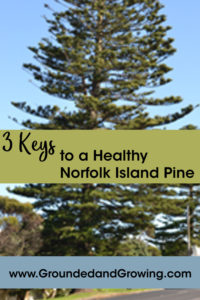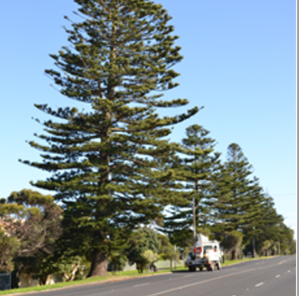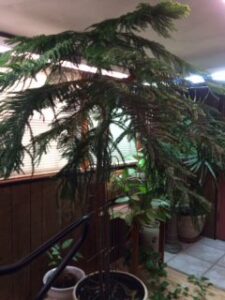 Norfolk Island pines can be a great houseplant with a little attention to available light, humidity and water.
Norfolk Island pines can be a great houseplant with a little attention to available light, humidity and water.
This post includes affiliate links for your shopping convenience.
If you happened to buy or receive a Norfolk Island Pine this holiday season, you might wonder– is there a Norfolk Island? Yes, Virginia, there is a Norfolk Island. It’s located in the South Pacific between Australia, New Zealand, and New Caledonia. It’s an Australian territory, and its flag prominently features the Norfolk Island pine.
In my years as an Extension educator, I received lots of questions, not just from Illinois but from all over the world since my articles have always been online. A reader from Australia e-mailed me to ask about his Norfolk Island Pine. It sounded like a typical question until I looked at the attached picture and realized the tree was growing in his landscape, not a potted houseplant!

Norfolk Island pine near an Australian reader’s home.
He explained it had been a wet winter and the tree had begun to lean. This was especially worrisome since it was also growing on a slope above his house. He wanted to know what I thought. I urged him to consult with a local tree service that could see the tree in person, considering I was half a world away!
In its native island habitat, the Norfolk Island pine bears little resemblance to the potted plants offered for sale here in Illinois. They are slow growers, but at maturity, they can be 150 or even 200 feet tall, with trunks up to 10 feet in diameter!
Norfolk Island pines are very tolerant of soil with high salt concentrations. This trait is essential for it to survive in the coastal regions of Norfolk Island. It also grows well in very sandy soil, again an advantage in coastal areas.
High salt tolerance turns out to be a benefit for growing as a houseplant. The Norfolk Island pine should tolerate salt buildup from fertilizers quite well. This doesn’t mean you should over-fertilize, or let these salts build up on purpose. The tolerable window is a bit larger for the Norfolk Island pine, giving us more time to correct growing conditions than with some other plants. I love forgiving plants!
Norfolk Island pines are used for timber, but their wood is relatively weak. Hawaiians use it for woodturning, a decorative art which carves wood turned on a lathe. The fact that Norfolk Island pines tend to grow with very straight trunks is probably one reason they are used for this craft.
As a landscape tree, Norfolk Island pines are generally very resilient in the face of high winds. However, they are severely sensitive to frost, and frost damage will weaken the tree. A tree weakened by frost produces multiple weak trunks which cannot tolerate high winds. In hurricane-prone locations, some towns have limited or prohibited the use of Norfolk Island pines in the landscape.
Interestingly, hurricane-prone South Florida is also the major producer of Norfolk Island pine seedlings for the houseplant industry. The trees are commonly sold spray painted to make them extra-green and decorated as holiday trees. To some, these are “disposable plants” to throw away after the holidays—but with a little TLC, they don’t have to be.
A little attention to available light, humidity, and watering will keep your Norfolk Island pine looking good for many years to come.
Light:
Available light is critical for successfully growing Norfolk Island pine. They need as much bright indirect light as possible. While they can tolerate lower light levels, they need to adjust to lower levels over time. A sudden change in lighting all at once may cause entire branches to die and drop from the plant. A change many of us don’t think about is the lighting change from a greenhouse or bright store to our relatively darker homes can be enough to cause some branches to drop.
Humidity:
Norfolk Island pines typically grow in coastal regions, which are by nature very humid environments. Unfortunately, most of our homes are way too dry for Norfolk Island Pines—they need some extra humidity.
Increase humidity by filling a saucer with water and rocks or gravel, and place the plant on top without the pot touching the water. This creates a microclimate of higher humidity around the plant. For a larger group of plants, consider using a humidifier. The Norfolk Island pine and the rest of your houseplants will appreciate the effort.
High humidity also discourages spider mite, a common houseplant pest. As the name spider mite suggests, the mites slowly engulf the plant in a webby material. While spider mites can be treated with a variety of insecticidal soaps and other treatments indoors, increasing humidity is a relatively simple way to prevent problems with this pest.
Watering:
Though Norfolk Island pines love humidity, this doesn’t mean we should water them more. They do not tolerate wet feet. In their native land, they thrive in sandy soil, which by nature drains well and doesn’t stay wet for very long.
A typical symptom of a Norfolk Island pine in distress is loss of the lower branches. Some loss of lower branches happens as the tree matures, but an excessive loss is a red flag. Unfortunately, the branches won’t grow back. If this is happening to your tree, check the growing conditions. Most likely the problem lies in too little available light, too much or too little moisture.
Helpful Supplies for Norfolk Island Pines
- Lighting— Dim lighting indoors will cause branches to drop from Norfolk Island Pines. My favorite compact LED grow light for table or countertops is this one with multiple goosenecks. As your tree gets bigger, you’ll want to switch to larger LED light sources and bulbs to provide enough light for your tree.
- Plant Caddy/Cart— Norfolk Island Pines can get huge indoors– and tough to move. Invest in a plant caddy or cart to make moving your plant easier on your back!
- Humidifier— Using either a room or whole-house humidifier makes it easier to provide the high humidity Norfolk Island Pines prefer. We bought this whole-house humidifier a few years ago and love it.
- Fertilizer— Pick a general purpose fertilizer and use it throughout the summer. Liquid, water-soluble powder, or solid spike formulas are all great. Also, fertilizing in winter without adequate light can lead to weak growth susceptible to pests and disease.
- Spider Mite Control— At my house, preventing spider mites is a lot easier than eliminating them once they show up. Increasing humidity with a humidifier will go a long way in preventing spider mite infestation. If they do show up, using insecticidal soap with added pyrethrin and/or neem oil is your best defense. The insecticidal soap and pyrethrin kill adult spider mites on contact, and neem oil kills the eggs and larvae.
Can You Prune a Norfolk Island Pine?
To quote a favorite professor of mine, “It depends”. You can prune any plant. The better question is “should you prune a Norfolk Island pine?”

This Norfolk Island pine is outgrowing its living arrangements in a basement under grow lights.
In extreme cases, I’ve seen Norfolk Island pines with long snaking main trunks bare except for a tuft of new growth at the top. While you can cut back a plant that has lost its lower branches, realize this will permanently distort the plant, and will likely result in a multi-stemmed plant.
Several years ago, a reader sent me the picture on the right and asked what could be done to prune this Norfolk Island pine. It was clearly outgrowing the space it was in, and it had a lot of sentimental value to the reader.
Many of you are probably familiar with the idea of removing the tip of a branch or stem to stimulate lateral buds along the branch or stem to grow. This phenomenon does not happen with the Norfolk Island pine, so I told the reader that they could prune some of the branches back a bit to reduce the tree’s width without stimulating growth.
The tricky part is what to do about the height. The growing point for a Norfolk Island pine is at the top. Reducing the height by removing any part of the growing point on top will stimulate multiple new growing points making the tree appear to have multiple stems from the cut portion upwards. While it won’t kill the tree, it does destroy the symmetry and form of the tree that draws most people to the tree in the first place.
The thing to keep in mind if you are contemplating pruning your Norfolk Island pine is the fact that you are fighting against the tree’s natural programming to be over 100 feet tall! In all honesty most people don’t keep Norfolk Island pines alive and healthy long enough to worry about them hitting the ceiling.
I had one that got to be more than five feet tall, but it got so ragged looking it just wasn’t pleasant to have around anymore. Some of this was normal for a maturing tree, but a good portion of its ragged appearance was caused when I moved and didn’t have adequate light available anymore. But for the previous years that I had the tree, it was really a fun plant to decorate during the holidays, and it needed relatively little care and attention the rest of the year as long as it had adequate light and moisture.
If you liked this post, please subscribe to Grounded and Growing today and receive your copy of “15 Tips to Become a '15 Minute Gardener'” so you can spend less time working ON your garden and more time enjoying being IN your garden.! It’s absolutely free. When you join the Grounded and Growing community, you’ll finally take the garden off your “To-Do” list and allow yourself time to enjoy your garden and savor the peace and serenity there. I tell subscribers about new posts as soon as I hit ‘publish’ and send weekly-ish updates on what’s going on in my garden– good, bad AND ugly.
 All Rights Reserved. © 2019 Jennifer Schultz Nelson.
All Rights Reserved. © 2019 Jennifer Schultz Nelson.
Hey, Jen! I have 2 Norfolk pines…one at home and one in my office. They’re “okay,” but I would like to see them grow fuller. Any advice on an ideal fertilizer to accomplish this? Thanks!
Hi Karina, great to hear from you– and thanks for reading! A fellow horticulturist friend was trying to be serious when she told me “you know, it’s amazing how well fertilizer works when you remember to use it”. After we finished laughing, we talked about how such a simple thing is easy to overlook. I am terrible at remembering to stick to any sort of fertilizer schedule, so I just go with the “weakly, weekly” method, which is just applying a dilute solution every time I water (not necessarily weekly, but whenever the plant needs water). You’re not worried about flowering with the Norfolk pines, so any general purpose fertilizer that can be used indoors should be fine. I typically use something like Miracle-Gro, or Schultz’s that is a powder you mix with water, but I’ve also used fertilizer sticks from Miracle-Gro or Jobe’s for houseplants, or Miracle-Gro makes a foam for houseplants that you pump onto the soil surface and water in. The advantage of using the sticks is they last for a few weeks before they need replacing– but there’s the remembering factor again. Also keep in mind that fertilizer is not a light replacement; too much fertilizer in low light will just push a lot of weak growth. But if your plants are in decent light and you haven’t been fertilizing at all up to this point, a weak fertilizer solution is a great place to start and should give you great results.
Concerning fertilizer and the Norfolk island pine, I suggest using the pellet type that is slow release and with as low a nitrogen level as possible. I found a brand at the local home depot called dynamite, it works great due to a purported 6 mo release cycle, having a good mix of micro nutrients and minerals and low nitrogen.
I use this on all of our houseplants and our 6 ft tall Norfolk island pine as I do not want this tree growing any faster then necessary. It is about 3 ft from the ceiling right now so I would say we got another 5 yrs or so to enjoy it and we plan on selling this house and moving in 3 yrs so I hope the new owner will like it and keep it. Moving from left to right coast, to far to bring it along as it is kinda huge.
Hi Bob, thanks so much for the suggestion! I’m always curious about new fertilizers and love to hear what’s working for my readers. It sounds like you have a super healthy vigorous plant, and I think you’re right, it would be hard to move. If the person that buys your house doesn’t want it, you might try places like the library or a church that would have the large space it needs.
I live in S. TEXAS NEAR McAllen. I think I have an outdoor Norfork Island Pine. It is very tall and gets narrower at the top, soft long needles and snapped like a beautiful tall triangle. I have concerns that the lower branches near the ground are brown and falling off. The outside ones look fresh and have new growth. The rest of the tree is beautiful. We have had a dry winter so about once a week i put the hose on it at a slow trickle for about 6 hours. What do I need to do. I lo e that tree. I have thought of trimming a few of the lower branches that hang on the ground.
Hi Audry, thanks for your comment. If you do have a Norfolk Island Pine, it’s normal for them to lose lower branches as they age– at least to a point. It would help to know for sure whether you really have a Norfolk Island Pine. If you could send me pictures of the whole tree and some up close of branches/needles, that would be helpful. You can send to jen@groundedandgrowing.co At any rate, watering even established trees during extended dry periods is always a great idea.
I have an 11 year old Norfolk Pine, 5′ with good shape. I put this tree outdoors from April thru October and all was well until last year. The indirect light changed dramatically when when a large tree in my yard was removed causing my pine to receive strong sun. The 2′ to 3′ branches lost many needles and now are bare from the trunk to 10″ from branch tips. How do I stimulate needle growth?
Hi Jamie, thanks for your comment. Unfortunately I don’t know of any way to encourage those bare branches to re-grow needles. I don’t think its in the Norfolk Pine’s genes to be able to do so. What you can do though is make sure it’s well-fed and watered to encourage plenty of new growth. I would say any sort of general purpose fertilizer for houseplants would be sufficient. Also be sure to find a spot where it can receive a little less sun this year.
Hello from California! I have 6 Norfolk Island Pine trees on my property that are about 60-70 feet tall and are ~25 years old. Two of them have bifurcated trunks, starting at ~40 feet. Is that normal for this tree to bifurcate? How much taller will these beautiful trees grow? Any tips on caring for them, other than fertalizing them 1-2 times per year? Thanks!
Hello! My knowledge of Norfolk Island Pines is pretty limited in that I’ve only worked with them as houseplants. But I would say that the bifurcated trunks is a pretty common reaction to damage to the growing point. I’ve seen it happen on houseplant specimens. I’m not sure how much bigger your trees might get in your climate, but I would suggest contacting a certified arborist in your area and consult with them. They have the advantage of seeing the trees in person!